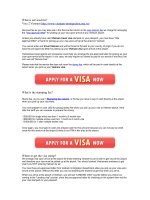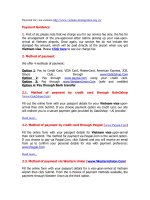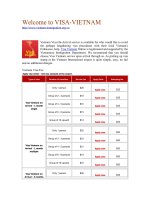UBI-GM-Presentation10.050121-wld org doc
Bạn đang xem bản rút gọn của tài liệu. Xem và tải ngay bản đầy đủ của tài liệu tại đây (949.65 KB, 18 trang )
Multinational Market Regions and Market Groups
Chapter 10
McGraw-Hill/Irwin © 2005 The McGraw-Hill Companies, Inc. All rights reserved.
PowerPoint presentation prepared by:
Alfred Lowey-Ball
Associate Professor of Marketing
UBI-United Business Institutes
Brussels, Belgium
Emergence of regional groupings
•
The evolution of regional groupings of nations is the most
important global trend in international business and today
•
Organizational form varies widely among market regions
•
The dominant motive for affiliation is economic and to have
greater weight in decision making
•
political benefits sometimes accompany
•
Examples: EU, NAFTA, Mercosur, ASEAN
Traits of Successful Economic Unions
1. Economic Compatibility (similar
economic systems)
2. Political Compatibility (similar
political systems)
3. Cultural Compatibility
4. Geographic factors
5. Weakness in some must be balanced
by strengths in others
Canada
Canada
United States
United States
Mexico
Mexico
Tariff shift rule
Tariff shift rule
•
Non-NAFTA imports undergo sufficient
manufacture or processing to become products that
can qualify under a different tariff classification.
•
Non-NAFTA imports undergo sufficient
manufacture or processing to become products that
can qualify under a different tariff classification.
Value-content rule
Value-content rule
•
A set percentage of the value of the good must be
North American (usually coupled with a tariff
classification shift requirement). Some goods are
subject to the value-content rule only when they
fail to pass the tariff classification test because of
non-NAFTA inputs.
•
A set percentage of the value of the good must be
North American (usually coupled with a tariff
classification shift requirement). Some goods are
subject to the value-content rule only when they
fail to pass the tariff classification test because of
non-NAFTA inputs.
Association of Southeast Asian Nations
(ASEAN)
Brunei
Brunei
Indonesia
Indonesia
Laos
Laos
Malaysia
Malaysia
Myanmar
Myanmar
Philippines
Philippines
Singapore
Singapore
Thailand
Thailand
Vietnam
Vietnam
ASEAN
•
Goal is economic integration and complementary
industrial programs
•
Not a political union
•
Basis for ASEAN Free trade area
•
tariff and non-tariff barriers phased out
•
Basis for ASEAN + 3: + China, Japan and So. Korea
•
set up after financial crisis of 1997/8
•
set up procedures to share foreign excahnge reserves
to defend one another’s currencies
Association of Southeast Asian Nations
(ASEAN) + 3
Brunei
Brunei
Indonesia
Indonesia
Laos
Laos
Malaysia
Malaysia
Myanmar
Myanmar
Philippines
Philippines
Singapore
Singapore
Thailand
Thailand
Vietnam
Vietnam
Japan
Japan
S. Korea
S. Korea
China
China
© 2004 The McGraw-Hill Companies, Inc. All rights reserved.
Asia-Pacific Economic Cooperation (APEC)
Australia
Australia
Brunei
Brunei
Canada
Canada
Chile
Chile
China
China
Hong Kong
Hong Kong
Indonesia
Indonesia
Japan
Japan
South Korea
South Korea
Malaysia
Malaysia
Mexico
Mexico
New Zealand
New Zealand
Papua New Guinea
Papua New Guinea
Peru
Peru
Philippines
Philippines
Russia
Russia
Singapore
Singapore
Taiwan
Taiwan
Thailand
Thailand
U.S.A.
U.S.A.
Vietnam
Vietnam
Future Multinational Trade Groups
1. United States/Japan
2. Hong Kong/Taiwan
3. Asia-Pacific Rim Countries
4. Hong Kong/Taiwan/Coastal Provinces of Southern China
5. Western Hemisphere (North and South America) F.T.A.
6. Transatlantic Free Trade Area (U.S.A. & EU)
7. NAFTA including Central America
8. SAFTA









